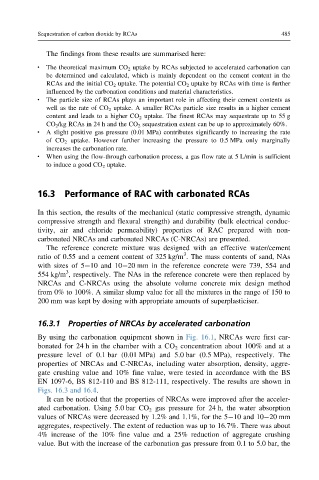Page 537 - New Trends in Eco efficient and Recycled Concrete
P. 537
Sequestration of carbon dioxide by RCAs 485
The findings from these results are summarised here:
The theoretical maximum CO 2 uptake by RCAs subjected to accelerated carbonation can
be determined and calculated, which is mainly dependent on the cement content in the
RCAs and the initial CO 2 uptake. The potential CO 2 uptake by RCAs with time is further
influenced by the carbonation conditions and material characteristics.
The particle size of RCAs plays an important role in affecting their cement contents as
well as the rate of CO 2 uptake. A smaller RCAs particle size results in a higher cement
content and leads to a higher CO 2 uptake. The finest RCAs may sequestrate up to 55 g
CO 2 /kg RCAs in 24 h and the CO 2 sequestration extent can be up to approximately 60%.
A slight positive gas pressure (0.01 MPa) contributes significantly to increasing the rate
of CO 2 uptake. However further increasing the pressure to 0.5 MPa only marginally
increases the carbonation rate.
When using the flow-through carbonation process, a gas flow rate at 5 L/min is sufficient
to induce a good CO 2 uptake.
16.3 Performance of RAC with carbonated RCAs
In this section, the results of the mechanical (static compressive strength, dynamic
compressive strength and flexural strength) and durability (bulk electrical conduc-
tivity, air and chloride permeability) properties of RAC prepared with non-
carbonated NRCAs and carbonated NRCAs (C-NRCAs) are presented.
The reference concrete mixture was designed with an effective water/cement
3
ratio of 0.55 and a cement content of 325 kg/m . The mass contents of sand, NAs
with sizes of 5 10 and 10 20 mm in the reference concrete were 739, 554 and
3
554 kg/m , respectively. The NAs in the reference concrete were then replaced by
NRCAs and C-NRCAs using the absolute volume concrete mix design method
from 0% to 100%. A similar slump value for all the mixtures in the range of 150 to
200 mm was kept by dosing with appropriate amounts of superplasticiser.
16.3.1 Properties of NRCAs by accelerated carbonation
By using the carbonation equipment shown in Fig. 16.1, NRCAs were first car-
bonated for 24 h in the chamber with a CO 2 concentration about 100% and at a
pressure level of 0.1 bar (0.01 MPa) and 5.0 bar (0.5 MPa), respectively. The
properties of NRCAs and C-NRCAs, including water absorption, density, aggre-
gate crushing value and 10% fine value, were tested in accordance with the BS
EN 1097-6, BS 812-110 and BS 812-111, respectively. The results are shown in
Figs. 16.3 and 16.4.
It can be noticed that the properties of NRCAs were improved after the acceler-
ated carbonation. Using 5.0 bar CO 2 gas pressure for 24 h, the water absorption
values of NRCAs were decreased by 1.2% and 1.1%, for the 5 10 and 10 20 mm
aggregates, respectively. The extent of reduction was up to 16.7%. There was about
4% increase of the 10% fine value and a 25% reduction of aggregate crushing
value. But with the increase of the carbonation gas pressure from 0.1 to 5.0 bar, the

